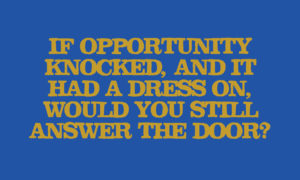How Ehrenberg Bass became a verb and destroyed the world.
In yesterday’s post, I started poking holes in the crutch that Ehrenberg Bass studies have become.
I have no fight to pick with the fine folk at the institute.
My beef is with those marketers who implement mass marketing campaigns because “We’re ‘Ehrenberg Bass’.”
Professor Byron Sharp very eloquently puts it, “The battle is for mental and physical availability.”
The endless morning meeting chants of “mass awareness” has given marketers all over Australia permission to target everyone in Australia with every communication.
The science is not wrong.
But the implementation seems to be short-sighted.
Interesting things start to happen when you couple the findings of the institute with another long term study (Field & Binet – The Long and the Short of It) which shows the power of emotional messaging. The study shows that relevant emotionally-based messages are twice as efficient as rational messaging and twice as profitable.
When it comes to the purchase decision, the emotional brain rules.
What Professor Sharp and his team have shown is, as long as you can be remembered, you’re more likely to be chosen at point of purchase.
What Binet and Field tell us is, emotions are better in the long run.
Be remembered.
Create powerful memory structures: simple, consistent brand assets that are easy to remember and, when seen or heard or smelled or touched or tasted, trigger instinctual responses.
Salience comes from availability, presence, immediacy, recency and insight.
It’s a balancing act between emotional relevance (how the customer becomes aware) and functionality (how they justify their decision).
There seems to be, for those of us in the cheap seats, battle lines being drawn between “mass awareness” and “mass targeting”. On one side, Lord Byron. On the other, leading the charge for the Targeteers, the ever-lovable Lord Potty Mouth, Professor Mark Ritson. (Who, yesterday, gave us this piece of scary future brilliance.)
Ehrenberg Bass has been kicking with the wind and seems to be winning.
Mass targeting got Trump elected. I think they may start fighting back.
And, while I can’t wait for the second quarter to begin, I can’t help thinking the marketers hoping for a knock-out victory from one side or the other (so they can then have more confidence in the media decisions they’re making) are watching the wrong game.
If science matters – whether the research findings of Ehrenberg Bass or the data minefield of the hyper-targeting army – why are so many marketers ignoring the really big numbers.
According to a Harvard Business Review article1 (by Michael J. Silverstein and Kate Sayre) there is a market segment which dwarfs all others, including the opportunities presented by China and India combined, ($18trillion versus 10.6trillion + $2.8trillion2) and which requires targeted thinking, but which can be reached by mass awareness campaigns.
Given the very real and very immediate economic challenges being faced by so many businesses, I’m surprised I’m not seeing more marketers screaming for a piece of that action.
A market which feel underserved, and which has proven to be receptive to relevant emotional messaging.
A market segment which not only will reward you in the short term, but will continue to reward your marketing efforts in the long-term, as long as you continue to prove your relevance.
A market segment that is four times the size of any other in terms of purchasing power.
Imagine if your marketing efforts could be four times more effective, just by tweaking your message.
Four times.
Take your present profit and loss sheet. Have a look at money made from sales. And multiply that by four.
Be conservative. Just double it.
Then ask yourself, “Why am I not marketing to women more?”
“Why am I not going all-out Ehrenberg Bass to women?”
Is it because Ehrenberg Bass has become shorthand for “advertise to everyone”?
Or is blandvertising more effective than we care to admit?
Again, and I can’t emphasise this enough, I am not criticising the institute. I’m questioning the interpretation of the thinking by marketers. There seems to be an explosion of all-things-to-all-people advertising. The beige-ness of this vision makes me worry for the future of this industry. It’s this kind of unconsideration which fosters unthinking. And unthinking will, I’m sure, destroy the world.
Perhaps I’m being a little melodramatic.
I’m being melodramatic.
Maybe there’s an answer in tomorrow’s final and exciting instalment.
Thanks for reading.
1The Female Economy, Silverstein and Sayre, HBR, 2009
2 Figures show global female wages versus GDP figures from 2015


Leave A Comment